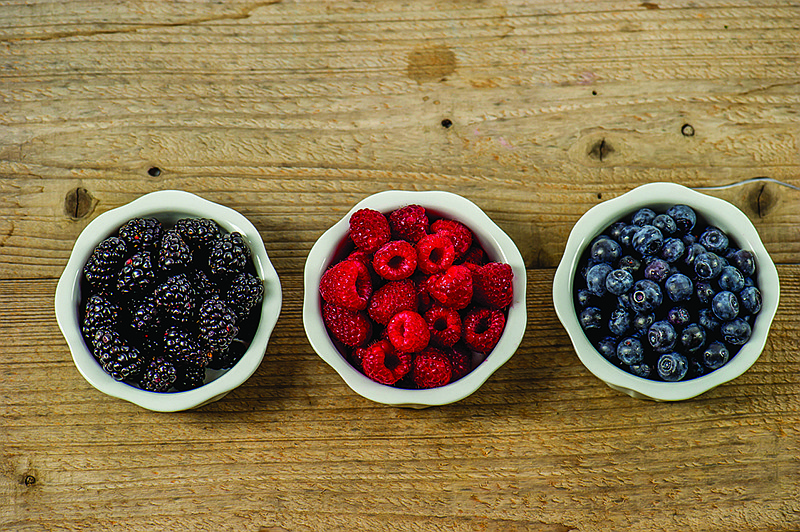It seems like there's always a new superhero movie playing at the movie theaters. Far from the silver screen (and much closer to your plate) are fruits and vegetables. Don't let them fool you - those insignificant-looking little guys are actually superheroes in disguise.
You may have heard of superfoods, which are often referred to by the news, magazines and health food enthusiasts. What does the term "superfood" actually mean? Superfoods are foods that are high in nutrients and are considered especially healthful.
Fruits and vegetables are packed with vital nutrients like vitamins, minerals and fiber. Vitamins and minerals are naturally occurring substances that we need for our bodies to work well and stay strong. We cannot make vitamins and minerals, so we have to obtain them from foods. Fiber is a non-digestible carbohydrate that has many benefits including lowering LDL (bad) cholesterol, making bowel movements more regular and easy to pass, feeding our good gut bacteria, and keeping us full longer.
Each individual fruit and vegetable has a different amount of nutrients. For example, blackberries have lots of fiber (about 8 grams of fiber per 1 cup of blackberries), while strawberries have less fiber (3 grams per cup) but more Vitamin C than blackberries. It's best to get a variety of fruits and vegetables to make sure you get a good balance of nutrients.
How many fruits and vegetables should we eat in a day? The current U.S. Department of Agriculture (USDA) recommendation is for adults to eat 1-2 cups of fruit per day, depending on age and gender. One cup of fresh fruit or cup of dried fruit counts as a cup-equivalent of fruit. Although 100 percent juice also counts as a fruit, eating the whole fruit provides more fiber. Check out the Choose MyPlate website for more information on how much fruit you need (based on age and gender) and how much of different fruits count as a cup: choosemyplate.gov/fruit.
The current USDA recommendation for vegetables is for adults to eat 2-3 cups of vegetables every day, depending on age and gender. One cup of fresh or cooked vegetables or 2 cups of raw, leafy greens counts as a cup-equivalent of vegetables. It's beneficial to eat a variety of vegetables from all the subgroups. Vegetable subgroups include dark green vegetables (such as broccoli and spinach), red and orange vegetables (such as carrots and tomatoes), beans and peas, starchy vegetables (such as potatoes and peas), and other vegetables (such as celery, cauliflower, cucumbers and green beans). Most people get plenty of the carbohydrates and other nutrients that are in starchy vegetables, so there's no need to eat extra of those. Look up the Choose MyPlate website for more information on how many vegetables you need and how much of different vegetables counts as a cup: choosemyplate.gov/vegetables.
Go out and find the fruits and vegetables you like to eat! Try to make half your plate fruits and vegetables at every meal. Those little superheroes are going to make you into a healthier you!
Lynn Grant is a registered dietitian and certified diabetes educator. She works at Capital Region Medical Center and provides diabetes education and outpatient nutrition counseling by appointment.
____
Spinach Salad with Apples, Eggs and Homemade Balsamic Vinaigrette
Spinach is a great source of Vitamin A, folate (Vitamin B9) and Vitamin K. Apples are a fantastic source of soluble fiber. Eggs, nuts and cheese provide protein. What a complete and delectable meal!
Makes: 4 servings
Salad
4 large eggs
2 gala apples (or your favorite kind!)
8 cups of spinach
1/2 cup dried cranberries
1/2 cup pecans (alternatives: walnuts, almonds, or pine nuts)
1/2 cup fat free crumbled feta cheese
Dressing
3 Tablespoons balsamic vinegar
2 teaspoons olive oil
Hard-cook the eggs by placing them in a saucepan large enough to hold the eggs in a single layer. Add cold water to cover the eggs by 1 inch. Heat over high heat until they are just boiling. Remove from heat and cover. Let eggs sit in hot water for 20 minutes. Drain and fill the pan with cold water, then let sit for 10-15 more minutes. Peel the eggs and slice them. Dietitian tip: you can do this ahead of time and keep the unpeeled eggs in the refrigerator until you're ready to use them!
Meanwhile, in a medium bowl, whisk together the balsamic vinegar and olive oil. Wash, slice, core, and cut up the apples. Wash and drain the spinach. Dietitian tip: a salad spinner is perfect for washing and draining leafy greens like spinach.
Place 2 cups of spinach on each of four plates. Top with eggs, apples, cranberries, pecans, feta cheese. Drizzle with the dressing. Serve and enjoy!
Nutrition per serving: 310 calories, 18 grams total fat, 3 grams saturated fat, 33 grams total carbohydrate, 6 grams dietary fiber, 12 grams protein, 600 milligrams potassium, 400 milligrams sodium, 230 milligrams phosphorus, 380 micrograms Vitamin A, 150 micrograms folate and 295 micrograms Vitamin K.
Adapted from recipe provided by "Fruits & Veggies: More Matters."


